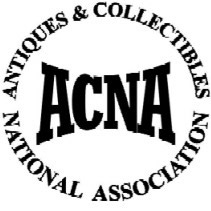Archived Products
Insect Napkin Ring Sterling Silver Vansant And Co 1875
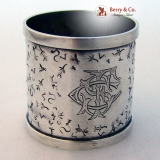
code: n1214
Sold
Figural Pond Lily Leaf Napkin Ring Whiting Sterling Silver 1875

code: n1217
Sold
Floral Scroll Shell Napkin Ring Repousse Whiting Stereling Silver 1890 Edna
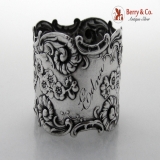
code: n1219
Sold
Chinese Export Silver Egg Cup Cherry Blossom 1900

code: wb3447
Sold
Art Nouveau Bee Cigarette Case 800 Silver

code: wb3448
Sold
Figural House Japanese Salt And Pepper Shakers 950 Sterling No Mono

code: wb3449
Sold
Repousse Baby Cup Wood And Hughes Sterling Silver 1880
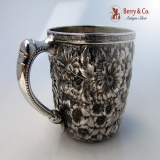
code: wb3450
Sold
Russian 84 Standard Silver Engraved Podstakannik Tea Glass Holder 1888
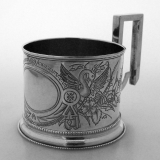
code: wb3438
Sold
Figural Corn Holders All Sterling Silver Pair Mauser 1900
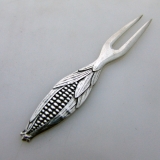
code: wb3439
American sterling silver figural all silver corn holders, sold by the pair, by the Mauser Manufacturing Company, c.1890 - 1910. These nicely detailed figural corn holders measure 4" long and weigh 14 grams each. The excellent original condition and clear, crisp detail, with no monograms, removals, repairs or alterations, make this an especially attractive offering. The soft, warm, original finish is present, with no buffing or machine polishing. The price is for one pair.
Sold
Bon Bon Spoon Figural Cherub Gorham Sterling Silver 1880

code: wb3442
Sold
Cake Basket Gorham Sterling Silver Swing Handle 1890
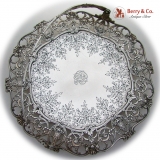
code: wb3441
Sold
Chinese Export Silver Desk Sander Seal Turtle 1890
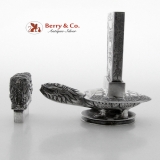
code: wb3443
Sold
Acorn Coin Silver Set 10 Teaspoons Farrington And Hannewell

code: wb3429
Sold
Persian Hand Engraved Sectional Serving Bowl 900 Silver 1900

code: wb3431
Sold
Henry R Percival Christening Cup 1854 Leonard Wilson Coin Silver 1854

code: wb3434
Sold
Jaccard and Co Early Coin Silver Small Cup St Louis Coin Silver 1840 No Monogram
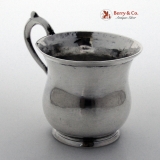
code: wb3435
Sold
Turkish Coffee Pot Sterling Silver Repousse Whiting 1880

code: wb3436
Sold
Ephraim Brasher Teapot Stand American Colonial Federal Coin Silver 1770 - 1790
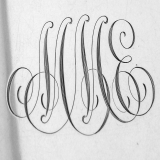
code: wb3427
American Late Colonial or Early Federal teapot stand by Ephraim Brasher of New York City, c.1770 - 1790. This wonderful teapot tray is 7 5/8" long, 5 3/8" wide, 7/8" tall and weighs 205 grams or 6.6 ozs. Troy. It bears the EB mark of Brasher′s, stamped twice, and a later mark: Old Silver, likely applied by an early 20th Century silver dealer. Seymour Wyler was known to have marked his antique silver in such fashion. Not generally practiced by dealers in Antique Silver today, such a mark adds interest to this already special piece. The center of the tray has a later monogram: MME. There are no removals and the scroll feet are in excellent condition. Monogrammed as described above, the soft, warm, original finish is present, with no buffing or machine polishing. The excellent original condition and clear detail, with no removals, repairs or alterations, make this an especially attractive offering. This is truly a rare form from an iconic American Silversmith. Ephraim Brasher (pronounced Bray-zher) lived just a few feet from President Washington in New York. Washington resided at 3 Cherry Street and Brasher lived next door at 1 Cherry Street. Some sources give the address of Brasher as 5 Cherry Street. Cherry Hill was a fashionable section of New York in the 18th century, located just north of the Manhattan side of the present day Brooklyn Bridge. His business address was 77 Queen Street, not too far north of his home. Brasher was born in 1744 and lived to 1810, the entire 66 years a resident of New York City. He was married to Anne Gilbert on November 8, 1766. Ann was a sister of another New York silversmith, William Gilbert. Some sources state that Brasher did not have any children with Anne, or with his second wife, Mary Austin, whom he married in 1797, sometime after Anne’s death. Other sources suggest that he did. Indeed, an article by Richard Bagg and Q. David Bowers in the February 1980 issue of The Numismatist, “Ephraim Brasher, Originator of the Famous Brasher Doubloon,†mentions Ephraim’s great-great-great granddaughter, Deborah. This alone would suggest that he did have children. Ephraim and Abraham Brasher both served their apprenticeship with a silversmith, whose name (or names) are not known today. Ephraim took his studies seriously, and today there is beautiful silverware that survives with his counterstamp. Little is known about Abraham or his work, but Ephraim did excellent work and many pieces of his craft are seen in New York and New England museums. Brasher was also a respected member of the community. In his March 1987 Coinage article, “The Brasher Bicentennial,†David T. Alexander noted: “In the late 1700’s, silversmiths and goldsmiths were particularly respected members of the community, often acting as bankers, assayers, and authenticators of the Babel of gold and silver coins of the world which circulated in the bullion-starved colonies and the new republic.†Not only were Washington and Brasher neighbors, but Washington was also a customer of Brasher. He owned numerous silver pieces made by Brasher, including a number of silver skewers with a surviving receipt. It was certainly important for Washington to make a good impression at state dinners, which he did with the assistance of his Brasher silver. Ephraim Brasher was a member of the New York Provincial Army in 1775 and 1776, serving the role of grenadier. He retired from the militia in 1796 with the rank of Major. Later, he served local politics in New York, almost like serving national posts at the time. New York was the leader of banking and foreign trade, and was also the new national capital. Brasher served on the New York Evacuation Committee in 1783, marking the departure of British troops from New York City. He also served as sanitary commissioner from 1784 to 1785, coroner from 1786 to 1791, assistant justice from 1794 to 1797, election inspector from 1796 to 1809, and commissioner of excise from 1806 to 1810. In addition to all of his service, and his private business affairs, Brasher served the United States Mint in the early 1790s. This is known from a Treasury Warrant in the amount of $27, paid to John Shield as “assignee of Ephraim Brasher.†This warrant was specifically identified as a payment for assaying work that Brasher performed in 1792 for the Mint, following instructions of the Secretary of the Treasury. CLICK HERE for more on Brasher
Sold
Georg Jensen Antelope Pin or Brooch 256

code: wb3432
Sold
Etruscan Homeric Set 54 Pieces Shiebler 1880 Sterling Silver Monogram K
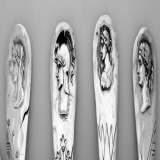
code: wb3422
- 11 Dinner Forks 8" long
- 11 Dessert Forks 7" long
- 12 Dessert or Oval Soup Spoons 6 7/8" long
- 9 teaspoons 6" long
- 11 Tablespoons 8 7/8" long
- Total weight 2545 grams or 81.8 ozs. Troy
Sold
Tiffany Napkin Rings Boxed Set 6 1864 Coin Silver
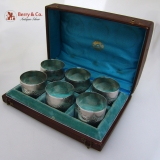
code: n1212
Sold
Repousse Sandwich Plate Scalloped Edge S Kirk Inc 1925 Sterling Silver
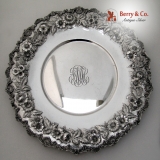
code: wb3421
Sold
Arts and Crafts Poppy Porringer Gorham Sterling Silver 1890
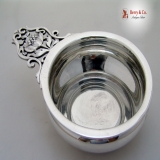
code: wb3416
Sold
Open Work Fleur-de-Lis Large Tea Ball Sterling Silver 1900
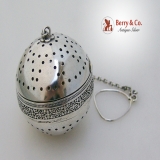
code: wb3418
Sold
Elizabeth Eaton 6 Rose Dessert Spoons 1848 Unicorn Crest Sterling Silver
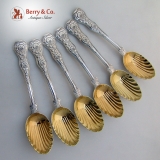
code: wb3411
Sold
Dolphin Desk Candlestick French 950 Silver 1820
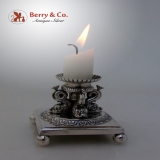
code: wb3417
Sold
Footed Beaker Gale Wood Hughes Coin Silver 1840 Gindrat
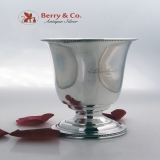
code: wb3407
Sold
Andersen Crown Arts and Crafts Serving Set 6 Hand Made Sterling Silver 1945
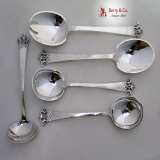
code: wb3410
- Gravy Ladle 7" 68 grams
- Serving Fork 8 3/4" 60 grams
- Serving Spoons 2 8 1/2" 60 grams each
- Serving Spoon 9 3/4" 101 grams
- Slotted Serving Spoon 9 3/4" 99 grams
- Total weight 452 grams or 14.5 ozs. Troy
Sold
Shakers Belleflower Happy Devil Masks Gorham 1892 Sterling Silver No Monogram
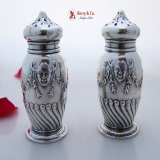
code: wb3406
Sold
Engraved Coin Silver Napkin Ring Wood And Hughes 1870
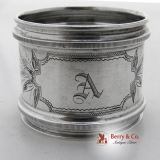
code: n1209
Sold

